
Author: Wilson Wu
My Insight to “Rent, Scenes from a Latin Quarter, and Opera presentation” by Wilson Wu
The movie “Rent” was fascinating in providing me with insight into how the political climate looked during the late 20th century by focusing on different groups of people who were affected by it. A gay couple, Mark and Roger, for example, had dreams of their own in the art field even when struggling to make ends meet. Even when Mark was on the verge of death from AIDS, he was willing to continue his music pursuit, which shows his passion for driving through it even when rising health conflicts are occurring to him. This relates heavily to my play “Angels in America,” when Prior Walter is left alone to share his voice with the public, despite being diagnosed with AIDS. The movie was presented with several emotional scenes that had my undivided attention, which included when Angels and Collin sang “I’ll Cover You” and Maureen’s protest. These scenes further allowed me to connect with the core message of the film, which is to live the best of life even when facing unpredictable circumstances.
Reading through the book “Scenes from a Latin Quarter”, I was able to get an overview of an alternative societal struggle that artists faced when pursuing their careers. These societal struggles involve generating less income and thus leave these artists facing numerous financial challenges. For instance, Marcel lived in poverty during his years as an early artist, as shown by his having to resort to borrowing clothes from friends, Marcel’s portrayal of bohemian life highlights this dependence on patronage and social networks, adding a layer of insecurity to Marcel’s situation. Marcel only began to find success and improve his finances after his recent literary work, “The Passage of the Red Sea,” became popular. Marcel’s motivation in pursuing his passion in the arts is very similar to Mark’s motivation. Similarly, Mark remained dedicated to his passion for making music right up until his deathbed, despite being diagnosed with AIDS.
Opera music was a genre of music I found fascinating throughout the Broadway performances I attended throughout my childhood. In the lecture, Amanda Hick did a fantastic job of explaining the origins of opera and how it transformed throughout history. It was interesting to me how opera started with themes that explored mythology and religion, which eventually spread to a variety of genres. I’ve also learned that composing opera music is quite different from composing pop music, as it involves the artist taking their lyrical style first before adding music to it. Throughout listening to all of the opera performances, my favorite one was from the artist Wagner. This was because of his style of music making me unable to hum to it, which gave me insight into the uniqueness behind opera.
My Insight to Punk Rock by Wilson Wu
The guest speaker’s introduction to punk rock was a fascinating thing in his early life. It all started in his childhood when he was taken by his uncle and aunt to a show. From there, Rich was inspired to make zines, which included band reviews and lyrics. Those zines are very similar to our Instagram posts in showing our loved ones and followers highlighting the aspects of a musician’s career or latest works. When Rich first saw his first punk rock show in Connecticut, he met with a lot of people through his zines and eventually wanted to form a band with them. This was an interesting event, as he noted that the event was predominantly male rather than women, as most of them were photographers.
Rich’s main intention in pursuing punk rock was mainly due to its uniqueness. At the time, punk rock was a relatively new genre of music and didn’t have much popularity during that time. He appreciated how punk rock broke conventional music norms and embraced a do-it-yourself approach. The lyrics often tackled social issues and personal struggles that gave it a depth that many other genres lacked, especially with asylum seekers crossing through the southern border when he performed in one of the southern states. What sparked me the most about Rich was his involvement in other art disciplines, like graffiti, when he moved to Brooklyn, Revs, and other musicians, where he found a vibrant community of artists and a new source of inspiration.
After hearing about his punk rock career, I felt inspired to research more about it. Punk rock pushed back against many expectations of what music should be like during its time. Eventually, it became so popular that those expectations no longer apply. When looking at the album covers that were passed throughout the class, I grew interested in the album cover designs and the old CDs that were encased in them. It made me wonder about the accessibility of these albums during the 20th century, especially when music applications weren’t available to purchase music. The gifts left by Rich of the old-fashioned stickers and pins were precious, and something that added something special to my music collection.
Wilson Wu’s Graffiti Art

My Insight to “The Women Who Gave Birth to Rabbits” at Macaulay Central by Wilson Wu
When I first read the playwright that was handed out in class, I was astonished by the sheer bizarreness of the whole pregnancy situation that was going on. Whilst Mary was giving birth to a child, Joshua and Thomas were discussing the future the child would have, especially predicting the gender that it’ll turn out to be. The moment that felt the most distributing though was when Mary gave birth to two rabbits, which created a sense of horror of the type of pain Mary had gone through. It was even more shocking when reading the dialogue of Thomas cracking jokes to lighten the negative mood around him, while Joshua was distressed about his lifelong dream of raising a baby boy. The concluding parts of the play were the most interesting part of the whole play, as the truths were later revealed to the reader on Joshua and Mary’s true intentions. Despite Joshua wanting to raise a baby boy, Mary didn’t agree with the idea but still gave in to Joshua’s desire. This resulted in catastrophe as they were arguing amongst one another about who was right and wrong.
All of the actors did a phenomenal job in acting out their characters. When I entered the building, I expected the actors to be fully dressed up and have props to act out certain scenes but was left with laughter seeing the actors dressed formally as they recited the playwright. Even so, though, it was interesting hearing the emotions that they were conveying, especially Mary’s disappointment when laughing at the irony of the whole situation and Thomas’s sense of silliness, as he tried making many jokes. The added dialogue was particularly very interesting, as the actors were putting their thoughts on how the scene would go outside the scope of a script and more into a real-life setting. The most important thing the actors did though was communicating to their audience. I sat on the back of the whole play, so I was able to witness the laughs that many of my classmates had when Mary and Maggie screamed as well as the saddened faces many had when seeing the terror on the face of Mary’s actor.
Learning about Stephen Garcia left me with something fascinating, especially learning about his perspective on the whole story he wrote alongside the stuff about art we discussed in class. I recalled the entire class being shocked when learning that the playwright was based on a true story that occurred in several hundreds of years before. Taking inspiration from this, it was interesting to hear that Garcia tried to navigate through the confusion of the whole situation by imagining what two people would discuss with one another, whilst the rabbit pregnancy was occurring. Lisa also brought up an interesting question to the actors and Garcia about the sense of morality that comes with putting a price tag on works of art, which connected heavily to what we learned about John Berger. It gives me awe when seeing Garcia’s experience with navigating around that difficulty, especially when being put off in putting things for free or at a relatively cheap price, even when the message of his plays is more important to him than the value of itself.
My Trip to the Night at the Museum (Brooklyn Museum) by Wilson Wu
INTRODUCTION:
After finishing all my Tuesday classes on October 15th, I was filled with excitement in having the rare opportunity to meet up with all four hundred of the Macaulay students. And so, I took the long fifty-minute drive to Prospect Park in preparation for this event. When I arrived, security greeted me and as usual checked my bag. I was able to easily locate all my Macaulay CSI friends, as they were all walking toward the auditorium on the third floor. Following multiple speeches made by the directors and deans of Macaulay, everyone parted ways throughout the museum, and off I went to my next art museum journey.
SECTION 1 (EARLY DYNASTY PERIOD CIVILIZATIONS):
“Cosmetic Palette” and “Cosmetic Dish in the Form of a Fish” Artifact
“Third Display” Artifacts
For more than thousands of years, the Brooklyn Museum has given me the invaluable opportunity to learn that art had always existed in early human civilization. As represented in the “Cosmetic Palette” artifact, both men and women had commonly used palettes like those in creating color paints when grinding certain materials. With sharp materials that were disposed of by these ancient humans, I’ve learned that they also find enjoyment in creatively carving stones to certain recognizable shapes around them, such as fish as shown in “Cosmetic Dish in the Form of a Fish.” The second display with the beaded necklaces fascinated me the most within this particular section of the museum because of its patterns being used in cultures that exist in the modern day. In many documentaries shown in school, I recall seeing indigenous groups and even modern-day tribesmen in Africa crafting beans out of wood and using stones to form lines of patterns on string, which created this sense of historical recognition when I first saw the third exhibit.
SECTION 2 (ANCIENT EGYPT):

“The New Kingdom Pair Statue” Artifact

“Relief of Amun, Ahmose-Negertari, and King Amunhotep I” Artifact
Ancient Egyptian cultures have fascinated me the most, as it has been widely documented and universalized in news articles and even pictures of the Great Pyramids of Giza. Upon looking at some artifacts, I’ve seen that many of them were made out of clay and were used highly to symbolize their rulers and certain animals that were common in Egypt. For example, I’ve learned that many Egyptian sculptures express bonds through sculpting two individuals like the “The New Kingdom Pair Statue”, which represents the connection of a scribe to a singer who appeared to look like one of the Egyptian goddesses. For some of these Egyptian artifacts, like in “Relief of Amun, Ahmose-Negertari, and King Amunhotep I”, I originally thought that the symbols around it were made for decorative purposes. After a quick Google search, I made on my phone, however, I learned later that the symbols were actually early Egyptian hieroglyphs that were used as their primary writing language. This made the art much more interesting to me, as many of the artifacts had embedded words that the artists wanted to openly express to their audience. Another interesting thing I’ve found that I forgot to take a photo of was the authentic mummies that were on display. It felt eerie when I looked inside an opened coffin with its interior contents on display. It raised a lot of questions to me of the sort of tasks archaeologists had to go through when uncovering a coffin in a crowded and unsanitary pyramid.
SECTION 3 (WESTWARD EXPANSION)/CONCLUSION:

“Man’s Shirt Cut” Artifact

“Painting #2” Artifact
The brand new fifth floor was an experience I was grateful for, being one of the very first few people to enter it before it was opened to the general public. Upon entry, I noticed that many of the works of art were dedicated to showing indigenous culture. The “Man’s Shirt Cut”, for example, gave me a look at the typical style of clothing many Native Americans were wearing before the early European colonization. Many of the pictures, like “Painting #2”, gave me a saddened emotion when seeing the early American settings during that time, especially the advanced machinery that farmers were using to display Native American land. These works of art have connected well to the feeling I’ll always get when entering my high school U.S. history class, having seen many of them on my teacher’s walls as well. After exploring the fifth floor, I was quick to examine other floors and see other cultures’ historical artifacts, but found out that I had run out of time. Despite this, I left the museum with a smile having seen artifacts and paintings that altogether told a story of how early civilizations had developed into the modern society that I live in today.
My Trip to the Banksy Museum by Wilson Wu
INTRODUCTION:
From traveling through Brooklyn to Manhattan, I felt satisfied with the easy commute I had to go to reach the Banksy Museum. There was only one train line I had to go to, which was the N train, which made the trip very cheap and accessible to reach the museum. After reaching Canal Street, I walked around to find the museum till I saw a photo of Banksy right on top of a 3-story building. Immediately I walked in and climbed the stairs to the cashier on the counter. After showing him my student ID, he gave me a discount to the point where I had to pay $26. When my ticket was paid, he pointed to the entrance of the third floor of the museum where my journey to the Banksy Museum would begin.
SECTION 1 (PALESTINE AND UKRAINE SECTION):




“The Bethlehem Wall” by Banksy


“Ukraine Murals” by Banksy
It was quite fascinating to observe art works, in which Banksy revealed his political stance on certain issues that were occurring in the world. Most notably, he has spread awareness through graffiti and even took the time to post them in his social media accounts to illustrate the damage that the wars in Palestine and Ukraine were to the innocent civilians who lived there. As shown in “The Bethlehem Wall”, he was willing to travel to a warzone area through a series of illegal tunnels to get his voice heard of the anger and disappointment he felt of the lost lives that were occurring. Many of the war paintings I’ve seen, such as Picasso’s “Guernica” that was discussed in one of the lectures, were all made by artists at their homes or pleasant locations and eventually shown in museums for display. Banksy, however, was very unique in that he was an artist who was willing to travel to dangerous places, in which many of them were bombed, to paint on damaged properties of what he thought were detrimental events that were occurring in those areas. This was also proven in the “Ukraine Murals”, especially with the street paintings of the woman holding a fire extinguisher while wearing a gas mask and the one with a child using judo on an old man. It just illustrates the high amount of unusual defense methods that innocent civilians had to go through when defending themselves in a war that they are not adapted to.
SECTION 2 (UNITED KINGDOM SECTION):
“Queen Vic” by Banksy
“Queen Ziggy Stardust” by Banksy
“Stop and Search” by Banksy
Banksy made many graffiti works in the United Kingdom that mostly depicted him questioning those who have a lot of power and influence on society. For instance, he was not afraid to voice his social criticisms towards many monarchs. Within the “Queen Vic” painting, he drew a figure of Queen Victoria sitting on top of a woman. The context behind this was fueled by his anger at Queen Victoria making a statement that opposed gay rights claiming that, “…women are not able to be gay.” This painting was created during a time when gay rights were limited in Great Britain. As a result, the artwork raised awareness about the tyranny of the monarch, who ignored the concerns of the people and failed to address them. Another work of art that Banksy made of a monarch was the “Queen Ziggy Stardust” painting. This piece of graffiti, however, was made to compliment Queen Elizabeth by depicting her as Ziggy Stardust who was a fictional character that became an icon in rock music. This can furthermore show Banksy the complementary thoughts he had on both characters and their similarities to one another. Other than monarchs, Banksy was also shown to heavily criticize British law enforcement. As shown in the painting “Stop and Search” a police officer stops and checks Dorothy’s bag from “The Wizard of Oz”. This shows the ridiculousness of Great Britain’s stop and search policy that was occurring during this time, as it highlights the violation of the rights of British citizens (Mainly of which belong to minority groups). Most of these people were also shown to be innocent, as represented by Dorothy and the flowers she had in her bag.
SECTION 3 (UNITED STATES AND FRANCE SECTION/CONCLUSION):
“If graffiti changed anything-it would be illegal” by Banksy
“Child Labor” by Banksy
The main icon that Banksy used in many of his drawings was that of a “Rat”. When graffiti was born in the 20th century, it was seen as a dangerous art tool because of its damage towards properties that were owned by property and business owners. Even if people want to get rid of them, I’ve learned that the “Rat”icon was used as a symbol by Banksy to show how graffiti artists cannot be easily disposed of in society. Furthermore, Banksy rather sees it as an important artist tool for street artists to spread their ideals on large objects to depict it towards a larger audience. This can further motivate social change and even cause people to recognize issues that they’ve never known before. One of these rat paintings is shown in “If graffiti changed anything it would be illegal”, which shows Banksy’s perspective on the mass impact graffiti has on people’s rights. I also started to gain a perspective on how Banksy’s artworks are not at all damaging to property owners. Mayor Bloomberg created a bounty hunt for Banksy fearing that his works would damage the reputations of many business owners. However, many of them are under the control of the property owners. One of those graffiti works was the “Child Labor” graffiti, which was painted in a Bronx property painting and was eventually removed to be stored. Many property owners would even go as far as to sell them to museums or auctions, which raised questions on their morality.
My Insight to “The Counter” at the Roundabout Theater by Wilson Wu
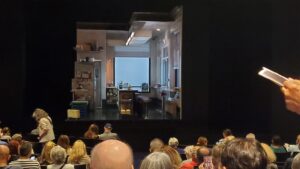
At first impressions when looking at the stage setup, I initially thought that the story would be a typical romance story of a man falling in love with a woman at a cafe counter. There was no reason to think of creating a story that mainly had two characters except for a love story, as there weren’t many side characters present to demonstrate other possible theater genres. I would later realize that the story is more than just a romance story, but rather follows the theme of friendship. This is an underrated genre that I feel many plays, TV shows, and movies don’t do a fantastic job of doing through their similar framework of friendship storytelling. When watching “The Counter”, however, I came to realize that my initial thinking of the play was entirely false.
Despite not admitting to it, Paul had undergone many rough periods of his life after having broken up with his true love at high school, developing PTSD from his firefighter career, and even having seen his loved ones at their deathbeds being mistreated by the staff at their nursing homes. Katie experienced a different kind of suffering that involved imposter syndrome through failing to contact her once true love and undergoing many surgical procedures that had her uterus removed. Paul, however, managed to share these experiences amongst himself and Katie by saying aloud, “Let’s be friends! Yes, the type of friends that share their secrets and talk about experiences they would never share with anyone else.” As a person who had many friends who sympathized with me during my stressful challenges in high school, I thus heavily related to Paul and Katie’s friendship and grew very content when seeing their friendship developing into one that’s very important in sustaining each of their lives.
The friendship bond didn’t form, however, until after a huge part of the story had unfolded. The beginning of the story felt very repetitive to me, as it was quite dialogue-heavy with Paul and Katie introducing themselves to one another and their lifestyles and interests. I strongly felt that the entire beginning could’ve been shortened to under a few minutes, as a play that has only 1 hour of screen time should be dedicated to plot development and landing the perfect ending that the audience could be satisfied with. Throughout the play, I laughed whenever Paul took his sweet time in wearing his heavy coat, carefully zipping it, and making a dramatic exit out of the cafe door. This is shown multiple times throughout the play, which illustrates an extreme repetition of events. Rather than having just that scene that spread no emotional impact to the audience, I think that the writers could’ve had Katie expressing her emotions of anger or sadness to the audience while cleaning up the Cafe in contrast to her leaving the scene in preparation for the upcoming one.
The beginning portion did feel like a very important unfolding of events in reaching the climax. I was beginning to get hooked up in the play when Paul offered Katie a type of poison that he wanted her to use to end his life. At that moment I asked myself, “What kind of friendship is this?” Eventually, though, I’ll learn that Paul is offering that poison through his high trust in Katie in getting his final wish to live in surprise within the last few moments of his life. Katie was the person that Paul would want to have breakfast with before the final few moments of his life because of the sense of comfort and empathy that Katie had given him throughout the rough periods of his life. The interactions between Paul and Katie arguing on the morality of poison were very emotional to me, as it expressed to me how much they meant to each other especially when sharing lifelong secrets. This trust in itself is what makes friendships very important, as it emphasizes the respect and support that are essential for meaningful connections.
At the end of the play when Katie got a voicemail from her ex-boyfriend in town, I almost shed tears when Paul jumped up and down in joy. The acting was top-notch and definitely impactful when having only two people discuss with one another their lifelong challenges. The silence between Paul and her ex-girlfriend was stunning, as I saw Paul’s expression of regret of not having spent his lifetime with his one true love. I wanted this acting to land a perfect ending, but instead left a cliffhanger that left many to question the events that would’ve happened. I’ve heard questions like, “Did Katie end up going back to date her old boyfriend?”, “Did Katie end up poisoning Paul that day?”, “Had Paul died shortly after Katie left the coffee shop?”. These lingering questions, in my opinion, shouldn’t be left out in any form of storytelling. This is because it emphasizes the lack of quality writing in closing the loose ends of the play to make the audience satisfied rather than craving any more events.
Tank Man – Protest Art, By: Wilson Wu
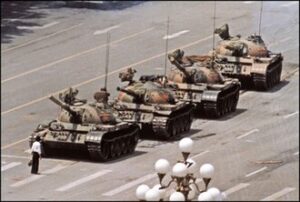
The “Tank Man” photograph is a piece of protest art that was taken in the 1990s that I find to be a historical piece of protest art. This photograph stood for the significance of what a singular person can accomplish in a protest, especially as someone who stood for his rights against the Chinese military’s orders by simply blocking their way in killing more civilians. This is proven in the photograph, as shown with the man having no weapons or any political status standing in front a huge row of tanks, even knowing the legal consequences he could face with the tank’s potential in eliminating him. This photograph captures the tension of that scenery when Deng Xiaoping initially carried out his execution orders through the numerous civil opposition that was against the Chinese Community Party’s political philosophy at that time.
It’s such a historical piece of art because there are very few pieces of art that have been captured of the Tiananmen Square Massacre, as a result of the Chinese government censoring and even removing any records that people have kept of this tragic event. It’s been heavily talked about in class about how historical art is a very important treasure in highlighting an artist’s mood and message, when he/she captures a particular historical event in his/her own perspective. The Deng Xiaoping administration wanted to destroy any evidence of the Tiananmen Square Massacre event occurring by targeting an enemy that was so large at that time: The media. Even with many of the photographs wiped from the reporters’ devices, many photographs and other forms of art (Eyewitness testimonies) still exist to shine light to the rest of the world of this tragic Chinese event in history. Although dictatorship had a profound effect on the Chinese citizens who’ve been forced to be silent after the event, I find it fascinating that there are still artists present that find ways to protect their form of art in an effort to get their voices heard.
My Trip to the Museum of Modern Art (MOMA) by Wilson Wu
INTRODUCTION:
It was a bright, but soon to be long day on my journey to the Museum of Modern Art (MOMA). Throughout my childhood, I’ve never really had the opportunity to visit art museums due to my lack of interest in art during that time. As a result, I was very excited to visit the MOMA, as it’ll mark my first ever art museum visit in my life. After getting off of 7th Avenue station, I took a 20 minute walk straight towards the outside of the MOMA. Immediately when reaching there, I was impressed by the smooth entrance I was able to get into the museum. It was a rapid process that involved going through security, double checking that everything is in my bag, getting my CUNY ticket, and walking towards my first ever art exhibit.
SECTION 1 (FREDERICK DOUGLASS ART SECTION):
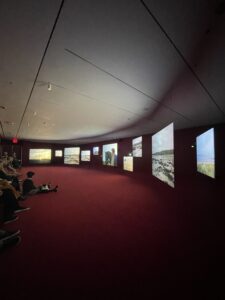
“Lessons of the Hour” by Sir Issac Julien
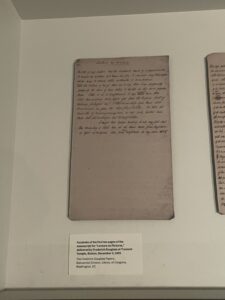
“Lecture on Pictures” by Frederick Douglass.jpg
After walking around the 1st floor for a bit, I noticed a huge crowd of people walking towards a room that seemed to show some sort of movie in there. Upon walking towards the crowd, I was amazed to witness the popularity and works of Frederick Douglass. It was a name I hadn’t seen since reading his book titled “Narrative of the Life of Frederick Douglass” in middle school. Even though I had a small glimpse of who Frederick Douglass was, reading his written documents on display gave me a refresher on his life under enslavement and his contribution to the abolitionist movement. It was also interesting to find a movie that was crafted in his honor, and was thus impressed by the clear historical events that Julien depicts in his Douglass’s narrative.
SECTION 2 (HISTORICAL ART SECTION):
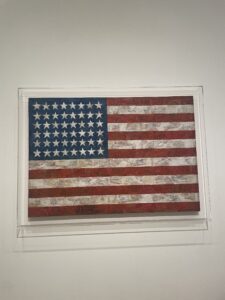
“Flag” by Jasper John
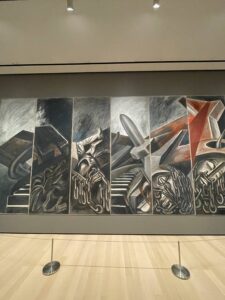
“The Charnel House” by Pablo Picasso
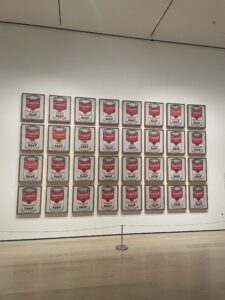
“Campbell’s Soup Cans” by Andy Warhol
It was also very fascinating to see the works that were drawn within the 19th-20th century because they depicted the situations that were arising at that moment. Jasper Johns’s ”Flag”, for example, allowed me to see notable differences between our current flag and the flag before the United States acquired both Hawaii and Alaska as official states. Upon searching the modern-day American flag, I was able to see the pattern of rows to be strikingly different and the brightness of the color that was painted in contrast to the computer-generated image of the modern-day flag. Looking through Pablo Picasso’s “The Charnel House” I was fascinated by the message he wanted to convey of the horrors of World War 2. Picasso, at first, was never one bit interested in painting anything that pertains to the theme of war, however the spread of Nazism and dictatorship in some parts of the world strongly persuaded him to illustrate to his audience the negativity those ideals played in the 1940s. Upon my journey on these historical paintings, I’ve realized that many of them were referred to as “Documents” in my history classes, as they were used mostly to support our historical claims. An example of this can be “Campbell’s Soup Cans” painting, which highlighted the typical, universal diet of many American workers during the 20th century. I remember in my U.S. history class, I had to use this painting as evidence to describe the toughness the American soldiers had to fight in the Cuban wars, mainly through eating soup meals day after day.
SECTION 3 (MATERIALISTIC ART):
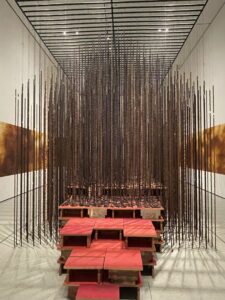
“House of Hope” by Montien Boonma

“Dial-a-poem” by John Giorno
It was also refreshing to see other pieces of art that were used to depict art other than paintings. Coming from a Chinese family that follows certain Buddhist traditions, Montien Boonma’s “House of Hope” reminded me of the very first temple I went to in China. The beads that were used for decoration reminded me of the relics the monks would put on when giving a lecture to an audience, alongside the red staircase illustrating to me happiness and prosperity just as the Chinese cultures would define the color. At the “Dial-a-poem” exhibit by John Giorno, I was able to explore auditory art by someone who gave it away to the public for free. By dialing the number the instructions asked me to, I was quick to pick up the stunning poem John Giorno had crafted within minutes about his opposition to the Vietnam War. It made me a little bit upset, especially hearing an artist reflecting upon the tragic loss of lives that were occurring from the war.
SECTION 4 (ABSTRACT ART SECTION):

“Exhibition C” by Piet Mondrian

“One: Number 31, 1950” by Jackson Pollock
The abstract art exhibit reminds me of the type of art that I’ve seen in my elementary school art room. The most notable painting my art teacher would clearly show on her wall was the “Exhibition C” painting by Piet Mondrian. To my four-year-old self at that time, nothing in the painting really stuck to me as art rather just a bunch of shapes jumbled up together. I feel like this perception was developed by seeing much more complicated portrait and landscape drawings in social media. It wasn’t until I discovered Jackson Pollock’s abstract paintings that I truly discovered the uniqueness of the drawings I would see in my elementary school art room. It was meant as a way to express one’s free mind when drawing, and how art especially is meant to communicate to the audience and doesn’t have to include any complicated details.
CONCLUSION:
Overall, my childhood perception of trips to art museums being boring was quickly proven wrong when I visited the MOMA and discovered many hidden treasures, resulting in my perception of art to change. I saw artwork that ranged from cultural paintings, historical pieces of art, and abstract art paintings, which altogether sparked my interest in researching more about international works of art that I hadn’t learned about in school. To my surprise, I discovered that many famous paintings convey deep messages, and thus I strongly encourage whoever is reading this to venture out to the MOMA and explore other paintings rather than just paying a visit just to see the “Starry Night”.








